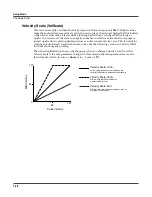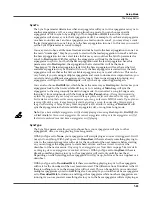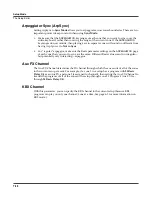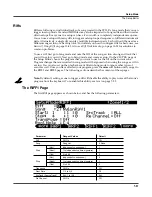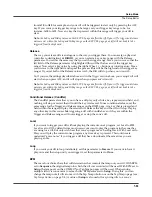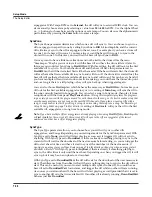
Setup Mode
The Setup Editor
7-41
Bipolar
starts out the same way as
Unipolar
, but during downward note shifting, it continues
past the original pitch until it hits the shift limit in the
opposite
direction, where it reverses again.
Float Res
adds a bit of apparent randomness to the process. “Float” means that when the
Arpeggiator reaches the shift limit, it resets—but not to its original pitch as with plain Reset.
Like Unipolar and Bipolar, it looks at the first note that would exceed the shift limit, and
calculates the interval between that note and the shift limit. It then restarts the cycle of latched
notes, transposing the entire cycle by the interval it just calculated, then shifting each
subsequent cycle by the value of Note Shift, until it reaches the shift limit again.
Here’s a very simple example. Suppose that the only note in the Arpeggiator cycle is C4, Note
Shift is
4
(a third), and Shift Limit is
7
(so notes won’t get shifted above G4). The Arpeggiator
plays C4, then E4. The next note should be G
#
4, but that’s above the shift limit—so the PC3LE
calculates the difference between that G
#
4 and the shift limit (G4): one semitone. It adds that
difference to the original starting note (C4) and plays that note next—C
#
4. The next note (F4) is
within the shift limit, but the next note (A4) isn’t, so it gets translated into D4—and so on.
Float Uni
uses the same concept and applies it to Unipolar mode: when the Arpeggiator reaches
the shift limit, it calculates the difference between the next note and the limit, and transposes the
next cycle of notes down by that interval, then shifts each subsequent cycle down until it reaches
the original pitch.
Float Bip
is similar to
Float Uni
, but the downward shift limit isn’t the
original pitch, it’s the negative of the Shift Limit value.
The Arpeggiator can be a lot of fun, even if you don’t always understand exactly what it’s doing.
Keep in mind that the stranger the algorithm you set up, the more unlikely the notes will stay
close to one key, so if you want to create something that’s going to sound at all diatonic, keep it
simple.
Shift Pattern (ShiftPatt)
ShiftPatt
engages a step sequencer for arpeggiator note patterns. The inputted note number of
each played key is shifted according to a sequenced pattern, thus “Shift Pattern.” There are 69
pre programed shift patterns including many useful chords, intervals, and rhythms. Each
pattern can have up to 48 steps, and each step can shift notes by ± 127 half-steps or play nothing.
Steps are played back at the rate set for
Beats
on the ARPEGGIATOR page. Keep in mind that
Shift Patterns are effected by every parameter on the ARPEGGIATOR page, which can be the
cause of unexpected variation, or a way to add interesting variation to a pattern.
Shift Patterns are most easily used and understood when triggered by only one key at a time.
One way to prevent triggering from multiple keys is to use one of the Latch types 1NoteAuto,
1NoteAutoLow, or 1NoteAutoHi when using a shift pattern (see
Latch
on page 7-43, below.)
Triggering shift patterns from one key allows the pre programed patterns to sound like what
you would expect from their names. If no other keys are playing, patterns will start over each
time a key is pressed
(there are some exceptions to this when using ARPEGGIATOR
Latch
parameters
other than “Keys,” though a newly triggered pattern will always start at step 1.)
When triggering Shift
Patterns from more than one key at a time, each consecutive step of the pattern shifts the note
from a different inputted key, the order of which is decided by the
order
parameter on the
ARPEGGIATOR page. This means that each key will not be shifted by every step of the pattern,
causing you to only hear part of the pattern from each key, often making the pattern
unrecognizable. Though triggering a Shift pattern from multiple keys can be used creatively, it
can also make it hard to predict what the output will be.
You can edit the included patterns by pressing “Edit” with a pattern highlighted in the
ShiftPatt
field
(see edit screen below
.
)
The top line of the “EditShiftPatt” page shows the full name for a
pattern whose name does not fit on the ARPEGGIATOR page. This page also displays the
pattern’s total number of steps, as well as pattern direction. Pressing
Step-
removes the last step
in the list, pressing
Step+
inserts a new note step at the end of the list (the pattern editor
remembers the values of removed steps until you save or exit.) Use the cursor to move between
Содержание PC3LE6
Страница 10: ...vi...
Страница 24: ...2 10 Startup Software Upgrades...
Страница 38: ...3 14 User Interface Basics Quick Song Recording and Playback...
Страница 42: ...4 4 The Operating Modes Using the Modes...
Страница 64: ...6 16 Program Mode The Program Editor...
Страница 134: ...7 70 Setup Mode The Control Setup...
Страница 138: ...8 4 Quick Access Mode The QA Editor...
Страница 194: ...10 34 Song Mode and the Song Editor Song Editor The EVENT Page...


